Miao Pan
University of Houston
PAE MobiLLM: Privacy-Aware and Efficient LLM Fine-Tuning on the Mobile Device via Additive Side-Tuning
Jul 01, 2025Abstract:There is a huge gap between numerous intriguing applications fostered by on-device large language model (LLM) fine-tuning (FT) from fresh mobile data and the limited resources of a mobile device. While existing server-assisted methods (e.g., split learning or side-tuning) may enable LLM FT on the local mobile device, they suffer from heavy communication burdens of activation transmissions, and may disclose data, labels or fine-tuned models to the server. To address those issues, we develop PAE MobiLLM, a privacy-aware and efficient LLM FT method which can be deployed on the mobile device via server-assisted additive side-tuning. To further accelerate FT convergence and improve computing efficiency, PAE MobiLLM integrates activation caching on the server side, which allows the server to reuse historical activations and saves the mobile device from repeatedly computing forward passes for the recurring data samples. Besides, to reduce communication cost, PAE MobiLLM develops a one-token (i.e., ``pivot'' token) activation shortcut that transmits only a single activation dimension instead of full activation matrices to guide the side network tuning. Last but not least, PAE MobiLLM introduces the additive adapter side-network design which makes the server train the adapter modules based on device-defined prediction differences rather than raw ground-truth labels. In this way, the server can only assist device-defined side-network computing, and learn nothing about data, labels or fine-tuned models.
SpeechVerifier: Robust Acoustic Fingerprint against Tampering Attacks via Watermarking
May 28, 2025Abstract:With the surge of social media, maliciously tampered public speeches, especially those from influential figures, have seriously affected social stability and public trust. Existing speech tampering detection methods remain insufficient: they either rely on external reference data or fail to be both sensitive to attacks and robust to benign operations, such as compression and resampling. To tackle these challenges, we introduce SpeechVerifer to proactively verify speech integrity using only the published speech itself, i.e., without requiring any external references. Inspired by audio fingerprinting and watermarking, SpeechVerifier can (i) effectively detect tampering attacks, (ii) be robust to benign operations and (iii) verify the integrity only based on published speeches. Briefly, SpeechVerifier utilizes multiscale feature extraction to capture speech features across different temporal resolutions. Then, it employs contrastive learning to generate fingerprints that can detect modifications at varying granularities. These fingerprints are designed to be robust to benign operations, but exhibit significant changes when malicious tampering occurs. To enable speech verification in a self-contained manner, the generated fingerprints are then embedded into the speech signal by segment-wise watermarking. Without external references, SpeechVerifier can retrieve the fingerprint from the published audio and check it with the embedded watermark to verify the integrity of the speech. Extensive experimental results demonstrate that the proposed SpeechVerifier is effective in detecting tampering attacks and robust to benign operations.
Budget-Adaptive Adapter Tuning in Orthogonal Subspaces for Continual Learning in LLMs
May 28, 2025Abstract:Large language models (LLMs) often suffer from catastrophic forgetting in continual learning (CL) scenarios, where performance on previously learned tasks degrades severely while training on sequentially arriving tasks. Although pioneering CL approaches using orthogonal subspaces can mitigate task interference, they typically employ fixed budget allocation, neglecting the varying complexity across tasks and layers. Besides, recent budget-adaptive tuning methods for LLMs often adopt multi-stage paradigms that decouple optimization and budget allocation. Such decoupling results in potential misalignment, which hinders those approaches' practical application in CL scenarios. To address these limitations, we propose OA-Adapter, a novel parameter-efficient approach for continual learning in LLMs that unifies dynamic budget adaptation with orthogonal subspace learning in a single end-to-end training stage. Specifically, OA-Adapter introduces a dynamic bottleneck dimension adaptation mechanism that simultaneously allocates an efficient parameter budget and optimizes task objectives without misalignment. To effectively preserve previously acquired knowledge while coordinating with the dynamic budget allocation, orthogonal constraints are applied specifically between the parameter subspace of the current task and the dynamically allocated parameter subspaces of historical tasks. Experimental results on continual learning benchmarks demonstrate that OA-Adapter outperforms state-of-the-art methods in both accuracy and parameter efficiency, achieving higher average accuracy while using 58.5% fewer parameters on the standard CL benchmark.
MobiLLM: Enabling LLM Fine-Tuning on the Mobile Device via Server Assisted Side Tuning
Feb 27, 2025
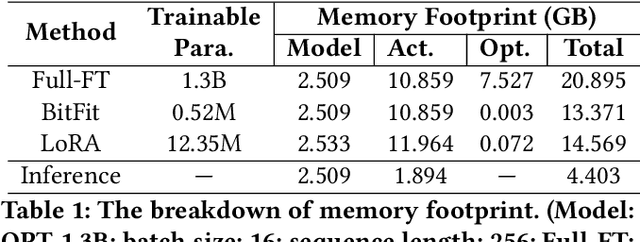
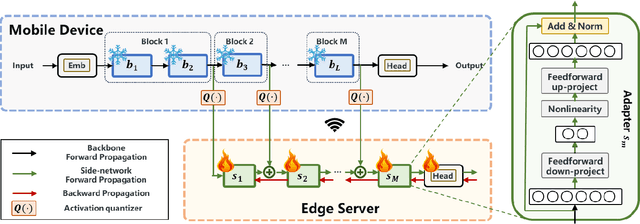

Abstract:Large Language Model (LLM) at mobile devices and its potential applications never fail to fascinate. However, on-device LLM fine-tuning poses great challenges due to extremely high memory requirements and slow training speeds. Even with parameter-efficient fine-tuning (PEFT) methods that update only a small subset of parameters, resource-constrained mobile devices cannot afford them. In this paper, we propose MobiLLM to enable memory-efficient transformer LLM fine-tuning on a mobile device via server-assisted side-tuning. Particularly, MobiLLM allows the resource-constrained mobile device to retain merely a frozen backbone model, while offloading the memory and computation-intensive backpropagation of a trainable side-network to a high-performance server. Unlike existing fine-tuning methods that keep trainable parameters inside the frozen backbone, MobiLLM separates a set of parallel adapters from the backbone to create a backpropagation bypass, involving only one-way activation transfers from the mobile device to the server with low-width quantization during forward propagation. In this way, the data never leaves the mobile device while the device can remove backpropagation through the local backbone model and its forward propagation can be paralyzed with the server-side execution. Thus, MobiLLM preserves data privacy while significantly reducing the memory and computational burdens for LLM fine-tuning. Through extensive experiments, we demonstrate that MobiLLM can enable a resource-constrained mobile device, even a CPU-only one, to fine-tune LLMs and significantly reduce convergence time and memory usage.
Distributed Perception Aware Safe Leader Follower System via Control Barrier Methods
Sep 17, 2024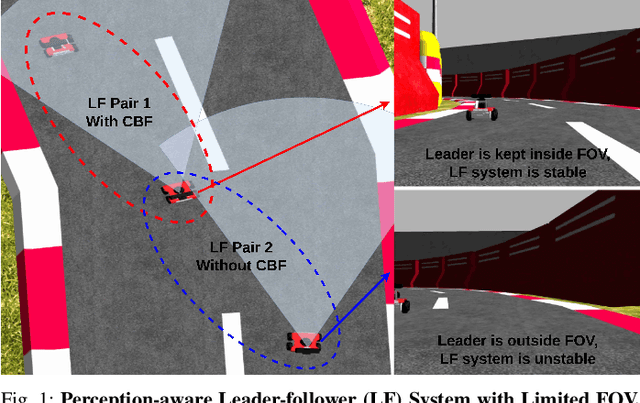
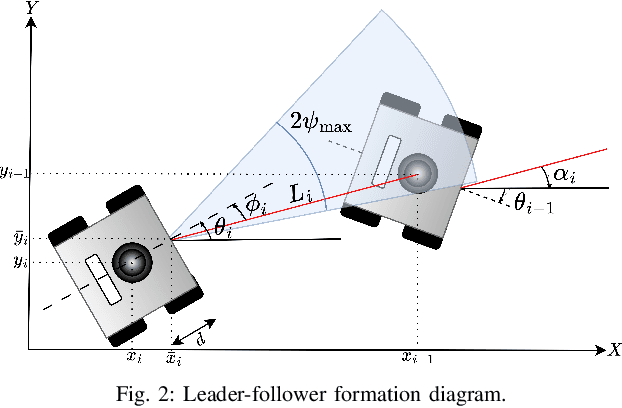

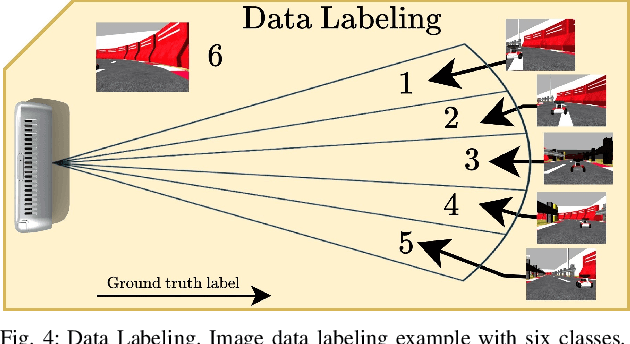
Abstract:This paper addresses a distributed leader-follower formation control problem for a group of agents, each using a body-fixed camera with a limited field of view (FOV) for state estimation. The main challenge arises from the need to coordinate the agents' movements with their cameras' FOV to maintain visibility of the leader for accurate and reliable state estimation. To address this challenge, we propose a novel perception-aware distributed leader-follower safe control scheme that incorporates FOV limits as state constraints. A Control Barrier Function (CBF) based quadratic program is employed to ensure the forward invariance of a safety set defined by these constraints. Furthermore, new neural network based and double bounding boxes based estimators, combined with temporal filters, are developed to estimate system states directly from real-time image data, providing consistent performance across various environments. Comparison results in the Gazebo simulator demonstrate the effectiveness and robustness of the proposed framework in two distinct environments.
FedEx: Expediting Federated Learning over Heterogeneous Mobile Devices by Overlapping and Participant Selection
Jul 02, 2024Abstract:Training latency is critical for the success of numerous intrigued applications ignited by federated learning (FL) over heterogeneous mobile devices. By revolutionarily overlapping local gradient transmission with continuous local computing, FL can remarkably reduce its training latency over homogeneous clients, yet encounter severe model staleness, model drifts, memory cost and straggler issues in heterogeneous environments. To unleash the full potential of overlapping, we propose, FedEx, a novel \underline{fed}erated learning approach to \underline{ex}pedite FL training over mobile devices under data, computing and wireless heterogeneity. FedEx redefines the overlapping procedure with staleness ceilings to constrain memory consumption and make overlapping compatible with participation selection (PS) designs. Then, FedEx characterizes the PS utility function by considering the latency reduced by overlapping, and provides a holistic PS solution to address the straggler issue. FedEx also introduces a simple but effective metric to trigger overlapping, in order to avoid model drifts. Experimental results show that compared with its peer designs, FedEx demonstrates substantial reductions in FL training latency over heterogeneous mobile devices with limited memory cost.
WHALE-FL: Wireless and Heterogeneity Aware Latency Efficient Federated Learning over Mobile Devices via Adaptive Subnetwork Scheduling
May 01, 2024Abstract:As a popular distributed learning paradigm, federated learning (FL) over mobile devices fosters numerous applications, while their practical deployment is hindered by participating devices' computing and communication heterogeneity. Some pioneering research efforts proposed to extract subnetworks from the global model, and assign as large a subnetwork as possible to the device for local training based on its full computing and communications capacity. Although such fixed size subnetwork assignment enables FL training over heterogeneous mobile devices, it is unaware of (i) the dynamic changes of devices' communication and computing conditions and (ii) FL training progress and its dynamic requirements of local training contributions, both of which may cause very long FL training delay. Motivated by those dynamics, in this paper, we develop a wireless and heterogeneity aware latency efficient FL (WHALE-FL) approach to accelerate FL training through adaptive subnetwork scheduling. Instead of sticking to the fixed size subnetwork, WHALE-FL introduces a novel subnetwork selection utility function to capture device and FL training dynamics, and guides the mobile device to adaptively select the subnetwork size for local training based on (a) its computing and communication capacity, (b) its dynamic computing and/or communication conditions, and (c) FL training status and its corresponding requirements for local training contributions. Our evaluation shows that, compared with peer designs, WHALE-FL effectively accelerates FL training without sacrificing learning accuracy.
Communication Efficient and Provable Federated Unlearning
Jan 19, 2024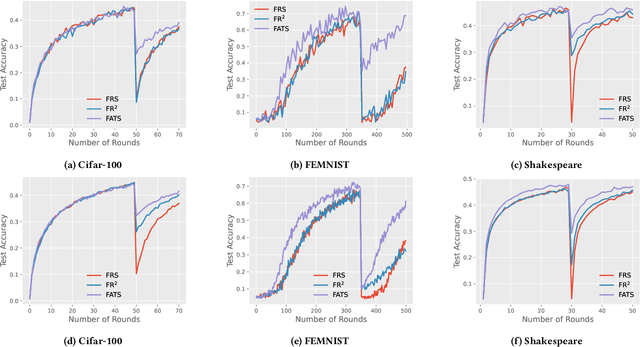

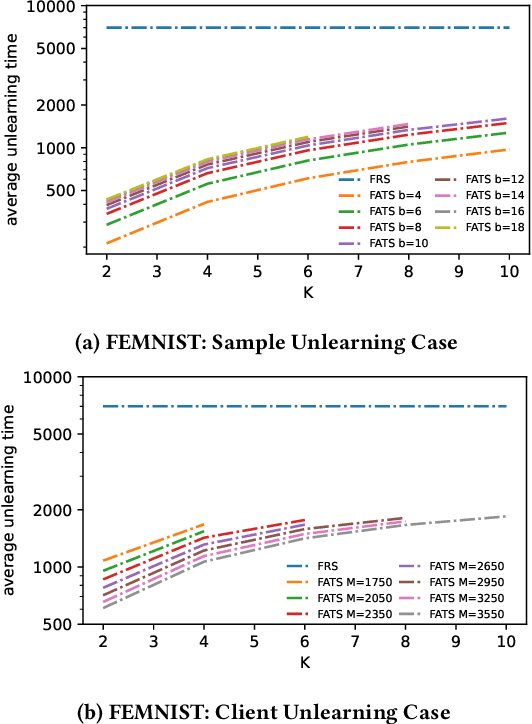

Abstract:We study federated unlearning, a novel problem to eliminate the impact of specific clients or data points on the global model learned via federated learning (FL). This problem is driven by the right to be forgotten and the privacy challenges in FL. We introduce a new framework for exact federated unlearning that meets two essential criteria: \textit{communication efficiency} and \textit{exact unlearning provability}. To our knowledge, this is the first work to tackle both aspects coherently. We start by giving a rigorous definition of \textit{exact} federated unlearning, which guarantees that the unlearned model is statistically indistinguishable from the one trained without the deleted data. We then pinpoint the key property that enables fast exact federated unlearning: total variation (TV) stability, which measures the sensitivity of the model parameters to slight changes in the dataset. Leveraging this insight, we develop a TV-stable FL algorithm called \texttt{FATS}, which modifies the classical \texttt{\underline{F}ed\underline{A}vg} algorithm for \underline{T}V \underline{S}tability and employs local SGD with periodic averaging to lower the communication round. We also design efficient unlearning algorithms for \texttt{FATS} under two settings: client-level and sample-level unlearning. We provide theoretical guarantees for our learning and unlearning algorithms, proving that they achieve exact federated unlearning with reasonable convergence rates for both the original and unlearned models. We empirically validate our framework on 6 benchmark datasets, and show its superiority over state-of-the-art methods in terms of accuracy, communication cost, computation cost, and unlearning efficacy.
Harnessing Inherent Noises for Privacy Preservation in Quantum Machine Learning
Dec 18, 2023
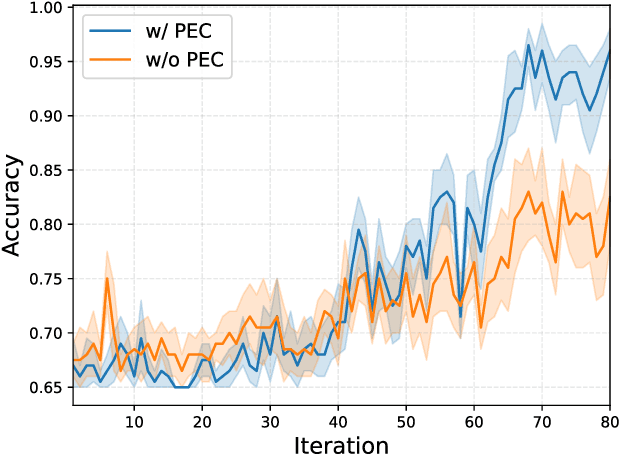


Abstract:Quantum computing revolutionizes the way of solving complex problems and handling vast datasets, which shows great potential to accelerate the machine learning process. However, data leakage in quantum machine learning (QML) may present privacy risks. Although differential privacy (DP), which protects privacy through the injection of artificial noise, is a well-established approach, its application in the QML domain remains under-explored. In this paper, we propose to harness inherent quantum noises to protect data privacy in QML. Especially, considering the Noisy Intermediate-Scale Quantum (NISQ) devices, we leverage the unavoidable shot noise and incoherent noise in quantum computing to preserve the privacy of QML models for binary classification. We mathematically analyze that the gradient of quantum circuit parameters in QML satisfies a Gaussian distribution, and derive the upper and lower bounds on its variance, which can potentially provide the DP guarantee. Through simulations, we show that a target privacy protection level can be achieved by running the quantum circuit a different number of times.
Eve Said Yes: AirBone Authentication for Head-Wearable Smart Voice Assistant
Sep 26, 2023



Abstract:Recent advances in machine learning and natural language processing have fostered the enormous prosperity of smart voice assistants and their services, e.g., Alexa, Google Home, Siri, etc. However, voice spoofing attacks are deemed to be one of the major challenges of voice control security, and never stop evolving such as deep-learning-based voice conversion and speech synthesis techniques. To solve this problem outside the acoustic domain, we focus on head-wearable devices, such as earbuds and virtual reality (VR) headsets, which are feasible to continuously monitor the bone-conducted voice in the vibration domain. Specifically, we identify that air and bone conduction (AC/BC) from the same vocalization are coupled (or concurrent) and user-level unique, which makes them suitable behavior and biometric factors for multi-factor authentication (MFA). The legitimate user can defeat acoustic domain and even cross-domain spoofing samples with the proposed two-stage AirBone authentication. The first stage answers \textit{whether air and bone conduction utterances are time domain consistent (TC)} and the second stage runs \textit{bone conduction speaker recognition (BC-SR)}. The security level is hence increased for two reasons: (1) current acoustic attacks on smart voice assistants cannot affect bone conduction, which is in the vibration domain; (2) even for advanced cross-domain attacks, the unique bone conduction features can detect adversary's impersonation and machine-induced vibration. Finally, AirBone authentication has good usability (the same level as voice authentication) compared with traditional MFA and those specially designed to enhance smart voice security. Our experimental results show that the proposed AirBone authentication is usable and secure, and can be easily equipped by commercial off-the-shelf head wearables with good user experience.
 Add to Chrome
Add to Chrome Add to Firefox
Add to Firefox Add to Edge
Add to Edge